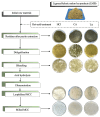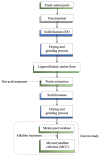Obtention and Characterization of Microcrystalline Cellulose from Industrial Melon Residues Following a Biorefinery Approach
- PMID: 39064864
- PMCID: PMC11279406
- DOI: 10.3390/molecules29143285
Obtention and Characterization of Microcrystalline Cellulose from Industrial Melon Residues Following a Biorefinery Approach
Abstract
Residual melon by-products were explored for the first time as a bioresource of microcrystalline cellulose (MCC) obtention. Two alkaline extraction methods were employed, the traditional (4.5% NaOH, 2 h, 80 °C) and a thermo-alkaline in the autoclave (2% NaOH, 1 h, 100 °C), obtaining a yield of MCC ranging from 4.76 to 9.15% and 2.32 to 3.29%, respectively. The final MCCs were characterized for their chemical groups by Fourier-transform infrared spectroscopy (FTIR), crystallinity with X-ray diffraction, and morphology analyzed by scanning electron microscope (SEM). FTIR spectra showed that the traditional protocol allows for a more effective hemicellulose and lignin removal from the melon residues than the thermo-alkaline process. The degree of crystallinity of MCC ranged from 51.51 to 61.94% and 54.80 to 55.07% for the thermo-alkaline and traditional processes, respectively. The peaks detected in X-ray diffraction patterns indicated the presence of Type I cellulose. SEM analysis revealed microcrystals with rough surfaces and great porosity, which could remark their high-water absorption capacity and drug-carrier capacities. Thus, these findings could respond to the need to valorize industrial melon by-products as raw materials for MCC obtention with potential applications as biodegradable materials.
Keywords: X-ray diffraction; biopolymer; circular bioeconomy; crystalline cellulose; food-waste biorefinery; melon residues.
Conflict of interest statement
The authors declare no conflicts of interest.
Figures







References
MeSH terms
Substances
Grants and funding
LinkOut - more resources
Full Text Sources

